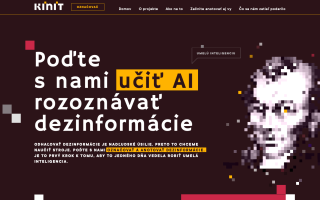What's
How did Oliver get into a disinformation bubble?
Kempelen Institute of Intelligent Technologies (KInIT) has launched a new animated website that explains in an engaging way how recommendation algorithms are used to spread misinformation on the Internet. The story is based on a study conducted by KInIT researchers. The website is accompanied by an educational video and together they illustrate that in a split second, anyone can find themselves in an online environment full of misinformation.
Manager Oliver finds himself sick in bed at home. After receiving a recommendation from a friend, he goes online for guaranteed advice on how to beat a common cold. He gradually works his way up from mistrusting painkillers to information about the dysfunction of conventional medicine. In the end, he is picked up by an ambulance after drinking a cleaning agent.
The Kempelen Institute of Intelligent Technology (KInIT) explains the mechanisms of how false content spreads on the Internet through the story of a young man. However, the focus of Oliver’s story is not him (his knowledge and behavior), but rather the technological cause of the spread of misinformation. “We wanted to highlight the powerful influence of the recommendation algorithms in locking users into a disinformation bubble.” explains researcher Jakub Šimko.
The story of Oliver shows how algorithms work and directly interfere in users’ lives without them realizing it. It explains simply how the system of personalized content and advertising works and how social media platforms earn money from it. It also describes the difference between social media and traditional media from a regulatory perspective.
The story is not just an imaginary scenario, it is based on the findings of the research paper “An Audit of Misinformation Filter Bubbles on YouTube”. In this paper, KInIT researchers investigated whether and with how much effort one can get out of disinformation bubbles.
KInIT has been working on detecting and limiting the spread of misinformation in the online environment for quite some time . “In the last two years, since the outbreak of the COVID-19 pandemic, the situation with disinformation in Slovakia has worsened significantly. Society is noticeably polarized and the spread of misinformation through social media affects everyday communication, discourse and events. However, people often do not understand the role social media plays in this conflict,” says Andrea Horváthová, the author of the story.
When creating the script, KInIT staff wanted to highlight the fact that the polarization of society is also largely caused by the decisions of technology companies. Anyone can find themselves in a vicious circle of misinformation on the Internet. It only takes a few clicks.


